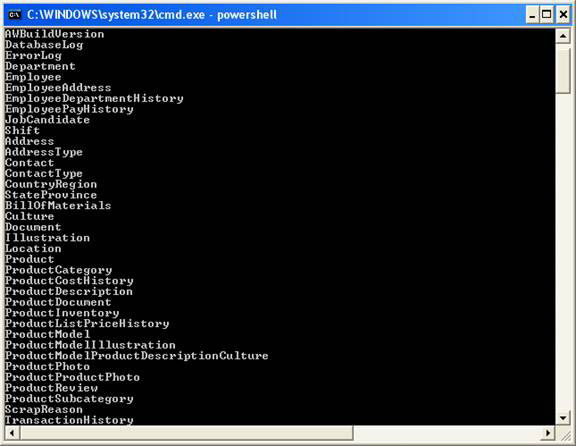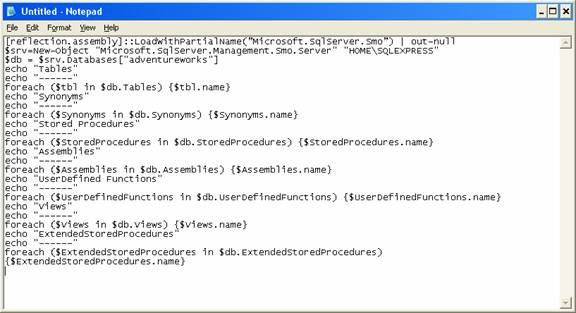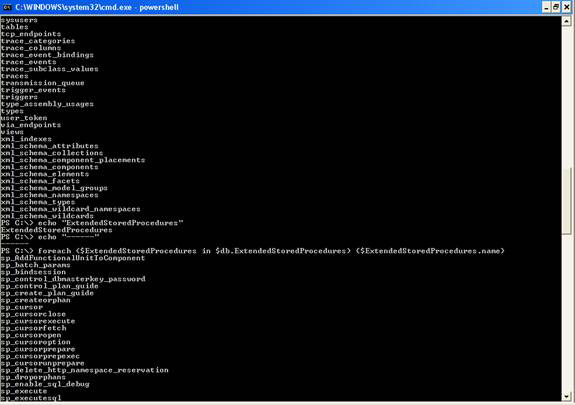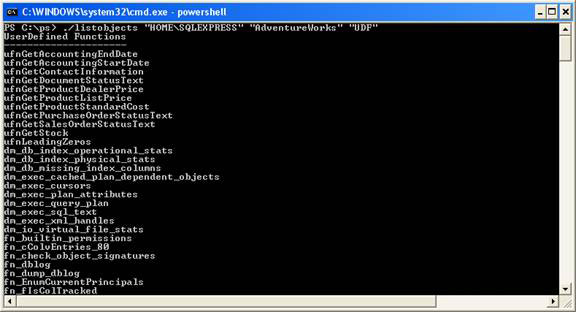![]() Microsoft Windows PowerShell và SQL Server 2005 SMO – Phần 1
Microsoft Windows PowerShell và SQL Server 2005 SMO – Phần 1![]() Microsoft Windows PowerShell và SQL Server 2005 SMO – Phần 2
Microsoft Windows PowerShell và SQL Server 2005 SMO – Phần 2![]() Microsoft Windows PowerShell và SQL Server 2005 SMO – Phần 3
Microsoft Windows PowerShell và SQL Server 2005 SMO – Phần 3![]() Microsoft Windows PowerShell và SQL Server 2005 SMO – Phần 4
Microsoft Windows PowerShell và SQL Server 2005 SMO – Phần 4![]() Microsoft Windows PowerShell và SQL Server 2005 SMO – Phần 5
Microsoft Windows PowerShell và SQL Server 2005 SMO – Phần 5![]() Microsoft Windows PowerShell và SQL Server 2005 SMO – Phần 6
Microsoft Windows PowerShell và SQL Server 2005 SMO – Phần 6
The MAK
Phần 1 và phần 2 của loạt bài này chúng tôi đã giới thiệu về cài đặt PowerShell và SMO đơn giản, WMI cmdlet. Trong phần 3 chúng tôi giới thiệu về cách lập kịch bản PowerShell để kết nối đến máy chủ SQL Server.
Phần 4 giới thiệu cách sử dụng kịch bản PowerShell để thực hiện hành động lặp một file và kết nối các máy chủ khác. Phần 5 giới thiệu cho các bạn cách tạo một cơ sở dữ liệu SQL Server bằng PowerShell và SMO. Phần 6 giới thiệu về việc backup cơ sở dữ liệu SQL Server bằng PowerShell và SMO.
Mỗi một phần trong loạt bài này đều minh chứng cách sử dụng PowerShell kết hợp với SMO để trình bày các đối tượng của SQL Server.
Phương pháp 1: Hiển thị các tên bảng
Chúng ta hãy giả dụ rằng mình muốn tìm tất cả các bảng đã có trong cơ sở dữ liệu “AdventureWorks”, trên máy chủ “HOME\SQLEXPRESS”. Thực thi lệnh dưới đây, tham khảo hình 1.1.
[reflection.assembly]:: LoadWithPartialName("Microsoft.SqlServer.Smo") | out-null
$srv=New-Object "Microsoft.SqlServer.Management.Smo.Server" "HOME\SQLEXPRESS"
$db = $srv.Databases["adventureworks"]
foreach ($tbl in $db.tables) {$tbl.name}

Hình 1.1
Cmdlets ở trên sẽ hiển thị các tên bảng trong cơ sở dữ liệu AdventureWorks trên máy chủ “HOME\SQLEXPRESS” (xem hình 1.2)
Kết quả
AWBuildVersion
DatabaseLog
ErrorLog
Department
Employee
EmployeeAddress
EmployeeDepartmentHistory
EmployeePayHistory
JobCandidate
Shift
Address
AddressType
Contact
ContactType
CountryRegion
StateProvince
BillOfMaterials
Culture
Document
Illustration
Location
Product
ProductCategory
ProductCostHistory
ProductDescription
ProductDocument
ProductInventory
ProductListPriceHistory
ProductModel
ProductModelIllustration
ProductModelProductDescriptionCulture
ProductPhoto
ProductProductPhoto
ProductReview
ProductSubcategory
ScrapReason
TransactionHistory
TransactionHistoryArchive
UnitMeasure
WorkOrder
WorkOrderRouting
ProductVendor
PurchaseOrderDetail
PurchaseOrderHeader
ShipMethod
Vendor
VendorAddress
VendorContact
ContactCreditCard
CountryRegionCurrency
CreditCard
Currency
CurrencyRate
Customer
CustomerAddress
Individual
SalesOrderDetail
SalesOrderHeader
SalesOrderHeaderSalesReason
SalesPerson
SalesPersonQuotaHistory
SalesReason
SalesTaxRate
SalesTerritory
SalesTerritoryHistory
ShoppingCartItem
SpecialOffer
SpecialOfferProduct
Store
StoreContact

Hình 1.2
Phương pháp 2
Giả dụ rằng bạn muốn tìm tất cả các đối tượng đã có trong cơ sở dữ liệu “AdventureWorks”, trên máy chủ “HOME\SQLEXPRESS”. Thực thi lệnh dưới đây, tham khảo hình 1.3.
[reflection.assembly]::LoadWithPartialName("Microsoft.SqlServer.Smo") | out-null
$srv=New-Object "Microsoft.SqlServer.Management.Smo.Server" "HOME\SQLEXPRESS"
$db = $srv.Databases["adventureworks"]
echo "Tables"
echo "------"
foreach ($tbl in $db.Tables) {$tbl.name}
echo "Synonyms"
echo "------"
foreach ($Synonyms in $db.Synonyms) {$Synonyms.name}
echo "Stored Procedures"
echo "------"
foreach ($StoredProcedures in $db.StoredProcedures) {$StoredProcedures.name}
echo "Assemblies"
echo "------"
foreach ($Assemblies in $db.Assemblies) {$Assemblies.name}
echo "UserDefined Functions"
echo "------"
foreach ($UserDefinedFunctions in $db.UserDefinedFunctions) {$UserDefinedFunctions.name}
echo "Views"
echo "------"
foreach ($Views in $db.Views) {$Views.name}
echo "ExtendedStoredProcedures"
echo "------"
foreach ($ExtendedStoredProcedures in $db.ExtendedStoredProcedures) {$ExtendedStoredProcedures.name}

Hình 1.3
Cmdlets ở trên sẽ hiển thị các tên đối tượng trong cơ sở dữ liệu AdventureWorks trên máy chủ “HOME\SQLEXPRESS” (xem hình 1.4)
Kết quả

Hình 1.4
Phương pháp 3
Hãy nối phương pháp 1 và phương pháp 2 thành một biểu mẫu kịch bản PowerShell để chấp nhận các tham số như bên dưới. Tạo file listobjects.ps1 như bên dưới.
param
(
[string] $ServerName,
[string] $DatabaseName,
[string] $ObjectType
)
[reflection.assembly]::LoadWithPartialName("Microsoft.SqlServer.Smo") | out-null
$srv=New-Object "Microsoft.SqlServer.Management.Smo.Server" "$ServerName"
$db = $srv.Databases["$DatabaseName"]
if ($ObjectType -eq "TABLES")
{
echo "Tables"
echo "------"
foreach ($tbl in $db.Tables) {$tbl.name}
}
if ($ObjectType -eq "SYNONYMS")
{
echo "Synonyms"
echo "--------"
foreach ($Synonyms in $db.Synonyms) {$Synonyms.name}
}
if ($ObjectType -eq "SP")
{
echo "Stored Procedures"
echo "------------------"
foreach ($StoredProcedures in $db.StoredProcedures) {$StoredProcedures.name}
}
if ($ObjectType -eq "ASM")
{
echo "Assemblies"
echo "----------"
foreach ($Assemblies in $db.Assemblies) {$Assemblies.name}
}
if ($ObjectType -eq "UDF")
{
echo "UserDefined Functions"
echo "---------------------"
foreach ($UserDefinedFunctions in $db.UserDefinedFunctions)
{$UserDefinedFunctions.name}
}
if ($ObjectType -eq "VIEWS")
{echo "Views"
echo "------"
foreach ($Views in $db.Views) {$Views.name}
}
if ($ObjectType -eq "XP")
{
echo "ExtendedStoredProcedures"
echo "------------------------"
foreach ($ExtendedStoredProcedures in $db.ExtendedStoredProcedures)
{$ExtendedStoredProcedures.name}
}

Hình 1.5
Bây giờ thực thi file listobjects.ps1 như bên dưới (xem hình 1.6)
./listobjects "HOME\SQLEXPRESS" "AdventureWorks" "UDF"

Hình 1.6
Giải thích về các tham số
listobjects là file kịch bản listobjects.ps1 trong thư mục c:\ps.
HOME là tên cấu hình
SQLEXPRESS là tên máy chủ SQL trên cấu hình chủ có tên HOME
AdventureWorks là tên cơ sở dữ liệu cư trú trong SQLEXPRESS.
UDF là một tham số, tham số này dùng để hiển thị tất cả các chức năng định nghĩa của người dùng trong cơ sở dữ liệu AdventureWorks.
Tham số hợp lệ cho các kiểu đối tượng là
UDF - User Defined Functions
TABLES - Tables
ASM - Assemblies
SP - Stored Procedures
XP - Extended Stored Procedures
VIEWS - views
SYNONYMS - synonyms
Kịch bản PowerShell ở trên hiển thị các tên của các đối tượng của một cơ sở dữ liệu cụ thể trong máy chủ. (xem hình 1.7)
Kết quả
UserDefined Functions
---------------------
ufnGetAccountingEndDate
ufnGetAccountingStartDate
ufnGetContactInformation
ufnGetDocumentStatusText
ufnGetProductDealerPrice
ufnGetProductListPrice
ufnGetProductStandardCost
ufnGetPurchaseOrderStatusText
ufnGetSalesOrderStatusText
ufnGetStock
ufnLeadingZeros
dm_db_index_operational_stats
dm_db_index_physical_stats
dm_db_missing_index_columns
dm_exec_cached_plan_dependent_objects
dm_exec_cursors
dm_exec_plan_attributes
dm_exec_query_plan
dm_exec_sql_text
dm_exec_xml_handles
dm_io_virtual_file_stats
fn_builtin_permissions
fn_cColvEntries_80
fn_check_object_signatures
fn_dblog
fn_dump_dblog
fn_EnumCurrentPrincipals
fn_fIsColTracked
fn_get_sql
fn_GetCurrentPrincipal
fn_GetRowsetIdFromRowDump
fn_helpcollations
fn_helpdatatypemap
fn_IsBitSetInBitmask
fn_isrolemember
fn_listextendedproperty
fn_MapSchemaType
fn_MSdayasnumber
fn_MSgeneration_downloadonly
fn_MSget_dynamic_filter_login
fn_MSorbitmaps
fn_MSrepl_map_resolver_clsid
fn_MStestbit
fn_MSvector_downloadonly
fn_my_permissions
fn_numberOf1InBinaryAfterLoc
fn_numberOf1InVarBinary
fn_repladjustcolumnmap
fn_repldecryptver4
fn_replformatdatetime
fn_replgetcolidfrombitmap
fn_replgetparsedddlcmd
fn_replreplacesinglequote
fn_replreplacesinglequoteplusprotectstring
fn_repluniquename
fn_RowDumpCracker
fn_servershareddrives
fn_sqlvarbasetostr
fn_trace_geteventinfo
fn_trace_getfilterinfo
fn_trace_getinfo
fn_trace_gettable
fn_translate_permissions
fn_varbintohexstr
fn_varbintohexsubstring
fn_virtualfilestats
fn_virtualservernodes
fn_yukonsecuritymodelrequired

Hình 1.7
Kết luận
Phần 7 của loạt bài này chúng tôi đã minh chứng về cách sử dụng PowerShell và SMO để tìm tất cả các đối tượng có sẵn trong một cơ sở dữ liệu trên máy chủ.
![]() Microsoft Windows PowerShell và SQL Server 2005 SMO – Phần 8
Microsoft Windows PowerShell và SQL Server 2005 SMO – Phần 8![]() Microsoft Windows PowerShell và SQL Server 2005 SMO – Phần 9
Microsoft Windows PowerShell và SQL Server 2005 SMO – Phần 9![]() Microsoft Windows PowerShell và SQL Server 2005 SMO – Phần 10
Microsoft Windows PowerShell và SQL Server 2005 SMO – Phần 10![]() Microsoft Windows PowerShell và SQL Server 2005 SMO – Phần 11
Microsoft Windows PowerShell và SQL Server 2005 SMO – Phần 11
 Công nghệ
Công nghệ  AI
AI  Windows
Windows  iPhone
iPhone  Android
Android  Học IT
Học IT  Download
Download  Tiện ích
Tiện ích  Khoa học
Khoa học  Game
Game  Làng CN
Làng CN  Ứng dụng
Ứng dụng 















 Linux
Linux  Đồng hồ thông minh
Đồng hồ thông minh  macOS
macOS  Chụp ảnh - Quay phim
Chụp ảnh - Quay phim  Thủ thuật SEO
Thủ thuật SEO  Phần cứng
Phần cứng  Kiến thức cơ bản
Kiến thức cơ bản  Lập trình
Lập trình  Dịch vụ công trực tuyến
Dịch vụ công trực tuyến  Dịch vụ nhà mạng
Dịch vụ nhà mạng  Quiz công nghệ
Quiz công nghệ  Microsoft Word 2016
Microsoft Word 2016  Microsoft Word 2013
Microsoft Word 2013  Microsoft Word 2007
Microsoft Word 2007  Microsoft Excel 2019
Microsoft Excel 2019  Microsoft Excel 2016
Microsoft Excel 2016  Microsoft PowerPoint 2019
Microsoft PowerPoint 2019  Google Sheets
Google Sheets  Học Photoshop
Học Photoshop  Lập trình Scratch
Lập trình Scratch  Bootstrap
Bootstrap  Năng suất
Năng suất  Game - Trò chơi
Game - Trò chơi  Hệ thống
Hệ thống  Thiết kế & Đồ họa
Thiết kế & Đồ họa  Internet
Internet  Bảo mật, Antivirus
Bảo mật, Antivirus  Doanh nghiệp
Doanh nghiệp  Ảnh & Video
Ảnh & Video  Giải trí & Âm nhạc
Giải trí & Âm nhạc  Mạng xã hội
Mạng xã hội  Lập trình
Lập trình  Giáo dục - Học tập
Giáo dục - Học tập  Lối sống
Lối sống  Tài chính & Mua sắm
Tài chính & Mua sắm  AI Trí tuệ nhân tạo
AI Trí tuệ nhân tạo  ChatGPT
ChatGPT  Gemini
Gemini  Điện máy
Điện máy  Tivi
Tivi  Tủ lạnh
Tủ lạnh  Điều hòa
Điều hòa  Máy giặt
Máy giặt  Cuộc sống
Cuộc sống  TOP
TOP  Kỹ năng
Kỹ năng  Món ngon mỗi ngày
Món ngon mỗi ngày  Nuôi dạy con
Nuôi dạy con  Mẹo vặt
Mẹo vặt  Phim ảnh, Truyện
Phim ảnh, Truyện  Làm đẹp
Làm đẹp  DIY - Handmade
DIY - Handmade  Du lịch
Du lịch  Quà tặng
Quà tặng  Giải trí
Giải trí  Là gì?
Là gì?  Nhà đẹp
Nhà đẹp  Giáng sinh - Noel
Giáng sinh - Noel  Hướng dẫn
Hướng dẫn  Ô tô, Xe máy
Ô tô, Xe máy  Tấn công mạng
Tấn công mạng  Chuyện công nghệ
Chuyện công nghệ  Công nghệ mới
Công nghệ mới  Trí tuệ Thiên tài
Trí tuệ Thiên tài